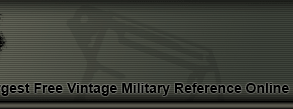
WWII GERMAN DAGGER - RAD SUBORDINATE HEWER
The German economy went through a depression during the early 1930's. The German government
created an organization called the RAD to boost the economy through employment generated by
the inception of massive public works projects. As a result of such effort the German
infrastructure was rebuilt producing things such as the Autobahn.
It is about this time that Hitler had launched an expansion of the armed forces. Service in the
military was deemed mandatory. The RAD was employed as a means to breach the time between
graduating from school to entering military service.
Service in the RAD included military style drills such as marching, obeying orders, etc.
In 1934 a dagger was issued to be worn by all members of the RAD organization. That dagger is
featured on this page.
|
The RAD dagger is one of the most interesting looking daggers of the Third Reich. Its roughed
appearance makes it look more like a utilitarian knife, closer related to a bolo knife than
a presentation dagger to be worn at parties, parades and special events. however, that is all
it was. A symbol of status among the members of the RAD organization.
The meaning of the word "hewer" which is "to make or shape with as or as if with an ax" evokes
the design of the dagger itself. It is very large and heavy. The handle is made of a thick
sheet of stag held together by two large screws. The pommel is rounded and has a protrution
similar to the beak of a bird.
The handguard resembles a toboggan. one end is straight while the other curves up. It is
composed of three lines that roll up into one.
The blade is heavy. Sligthly curved upwards and has a very irregular point. A blood groove
covering roughly 50% of the body of the blade is carved starting near the base.
The photos (right) show the RAD dagger in the scabbard and outside the scabbard. This is one
of the heaviest and most rugged daggers of the third reich.
The blade is very heavy duty and can hold an edge.
|
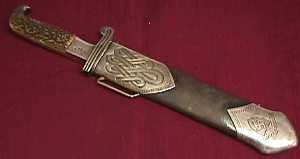

|
The scabbard of the dagger is very ornate. It is outfitted with two
large nickel fittings; one on the neck of the scabbard. In the shape of a broad arrow pointing
downwards. It has the portral of a Celtic swirl pattern.
Formed with double lines so as to allow space in between the lines which is filled with a rich
grooving pattern for further visual effect. Another added touch was the use of a line of
beads to follow the shape of the tip of the arrow of the fitting.
The throat section also comes with a wire bracket design so that the dagger hanger can be attached,
allowing the owner to secure the dagger to the uniform.
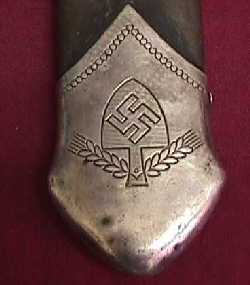
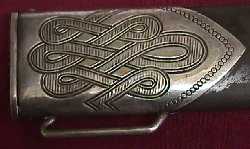
The fitting placed on the tip of the scabbard follows the shape of the scabbard and has a point
in the upwards direction. The fitting displays the RAD symbol in a very prominant manner.
Consisting of the head of a shovel standing up. A swastika is placed in the center of the
head. A wheat spear spreads outwardly from the left and tight side of the shovel head.
A pattern of beads trails the shape of the point of the fitting.
|
This page is a recognition and identification guide for German bayonets. Multiple
detailed photos of a specific sample are provided. Descriptions point out specific
points that should be noted.
One of the most commonly asked questions is "How much is my German bayonet worth?".
A price guide is included here to address this question. The value of the Nazi bayonets is
reviewed over a period of several years. A trend can be observed. The present worth
of the police sword in the collector's market is illustrated.
This service is provided free of charge to the visitor/enthusiast courtesy of
MilitaryItems.com,
a company dedicated
to the preservation of military history and to providing quality military antiques and
collectibles to museums, institutions and the general public.
|
|

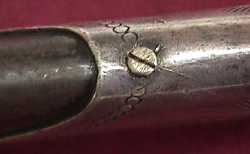
The shape of the mouth of the scabbard is triangular. This design matches the shape of the
blade with a blunt, thick back and a narrowing edge. The screws to the side of the fitting
serve a dual purpose. One is to make sure the fitting remains in place. The other is to
secure the runners that reside inside the scabbard. They hold the blade in place when it is
inserted in the sheath.
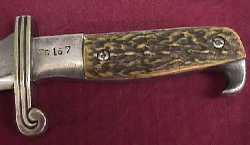

|
The serial number is only located on the left side of the handle. The two
pictures to the left illustrate the way in which the handle is held together. The right side
looks like a regular screw while the left side is closer to a nut. The handles are made of
a thick sheath of stag.
RAD DAGGER HANGER
Just like the hewer itself, the hanger for the RAD dagger is very large and of irrefular shape.
It consists of black leather straps with two heavy aluminum clips. Both are spring loaded. one
large leather section is built at an angle. This allows the dagger to be worn pointing forward
while the hanger remains straight.
Built with heavy duty stitching. Some of the brackets that secure the clips to the leather straps
were wire-type design. Others had a more robust square frame.
The back of the clips were often marked. The Assmann company (symbol "A") was a common
manufacturer for this part. Additional markings may include the RAD logo.
|
A unique characteristic of the RAD dagger was the angular shape of the blade
tip. The blade was marked at its base with the manufacturer's logo which consisted of two
vertical oval shapes, one inside the other, forming a space between the ovals where the name
"Ed Wusthof" is scrolled. This is the name of the company that manufactured the dagger. The
name of the town "Solingen" is placed in the lower section of the oval group.
Additional markings include a downward facing triangle with the letters RJAD placed inside the
figure and arranged themselvesin a triangular shape. The words "Ges Gesch", indicating trademark,
are placed just below.

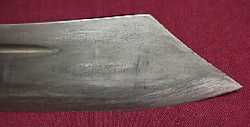
The blade has a blood groove on both sides. The right side contains a couple
of German words. The blade shown below has been sharpened on a wheel. This is
unfortunate because it reduces the value of the piece. Daggers should never be
sharpened.

The blade of the hewer displays the RAD's motto "Arbeit adelt" which translates to
"Labor enobles". It is written in large gothic letters and placed in the center of the body
of the blade.

A RAD Leader dagger was also produced.
It was issued to officers in the organization.
Many German edge weapons are currently
reproduced.
It is becoming more difficult to be able to tell the fake ones from the real ones because
the quality of the reproductions is improving. The collector must become familiarized with
the construction style and materials employed in the manufacturing of this item.
Attention to the details is critical in order to be able to determine the authenticity of
the collectible.
If you have an interest is seeing other edge weapons of the Third Reich, you can do so by going
to our
WWII German daggers and Swords
identification guide, Where we cover blades from the Heer (Army), Navy (Kriegsmarine), Air Force
(Luftwaffe) and other organizations.
| 

